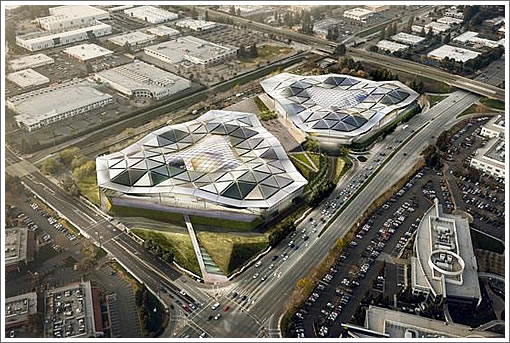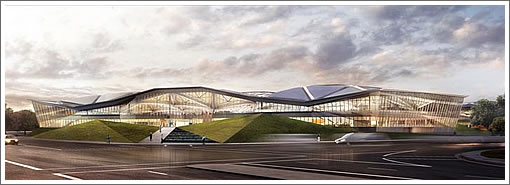
Following in the footsteps of Apple and Facebook, NVIDIA has announced plans for a new designer campus to be designed by architect Hao Ko, design director for Gensler’s San Francisco architecture studio, and to be built across the street from NVIDIA’s existing campus in Santa Clara.
The design harmonizes smart functionality and a shape that connects with and inspires our employees – a triangle, the fundamental building block of computer graphics. Efficient in every way, the design is thoughtful in its use of space, energy, and environment, and, of course, cost.

Its vast open floors will facilitate our cross-functional work. The nature of building our products requires experts from multiple disciplines to come together, and this building is designed above all for collaboration.
Construction on the first half of the campus is slated to start in June with occupancy in 2015.
I hope that in the next few years, one of these companies will build a designer skyscraper in the city instead of the valley. I don’t blame any of the existing ones for going the valley route (all their employees are there), but some quickly growing SF startups may think about doing this sometime soon.
I would agree. I would like to see them rethink their suburban mentality of land, parking lots and 3 story buildings.
Think of what they could do with a world class architect building a high rise complex with housing adjacent to our new Transbay Terminal in downtown SF.
I don’t share the designer skyscraper fetish of many here, but I would love to see more new tech companies locate in downtown SF, which we are already seeing with Salesforce, Twitter, etc. Really though, I’d prefer several hundred 500 footers be built (office and residential) than a few supertall ego boosters.
OMN – Why not just build a skyscraper in Santa Clara instead? There’s no reason that all tall buildings must be in SF.
Actually Silicon Valley is growing taller albeit with little steps. Over the past few years quite a few one and two story buildings have been razed and always replaced with something taller. There’s quite a few five+ story buildings under construction now which isn’t really a big deal by SF standards but quite a change in the south bay. Too bad they’re still accompanied with massive parking and lame transit. If anything limits Silicon Valley’s physical growth it is transportation, not an inability to build tall.
——————————–
N.B. – that triangular tessellated roof pattern on the nVidia buildings is an allusion to the core computational object that nVidia processors operate on. If you look real close at how a video game renders a scene you’ll see a lot of discrete polygons, most of them triangles.
Because, given a choice, most young and not so young tech workers would prefer to live and work in San Francisco.
futurist – if you replace “most” with “some” in your statement then I’d agree. I think your opinion has been colored by only knowing the subset of tech workers who already live in the city.
Why not build skyscrapers in in the city of Santa Clara? For one, I don’t think the city permits them.
Its vast open floors will facilitate our cross-functional work.
Vast open floors and 500′ buildings don’t mix. Darn elevators.
Most.
Joshua – Even without elevators the floorplan will be broken up by restrooms (generally placed near the center) and utility closets. But I get your point that in slender tall buildings the elevator/utility/restroom core consumes a much larger percentage of the floorplate.
I agree with the sentiment that it would be refreshing and progressive if a firm would build a a designer skyscraper in a city instead of a suburb. There’s nothing wrong with the established cities in the Santa Clara valley.
The “lameness” of the Santa Clara Valley Transportation Authority is, in my opinion as one who personally commuted daily using it during the height of the dot com era, largely due to the fact that everything is so spread out. Or lack of density if you prefer to look at it that way.
Which is another reason why building up rather than out is a better idea.
Brahma — it’s about trade-offs, and a larger footprint, flatter building provides a better work environment (in the judgement of these companies).
I’ve lived in SF and worked for Silly Valley companies for almost 15 years. I’ve been fortunate enough to work in a SF location or telecommute for about half of that time, but I can guarantee you that it’s not “most” tech employees that would prefer to live in the city. A Silicon Valley campus is not the hip, cool, young environment some people seem to think it is.
Sure, while the company is young and fast-growing that’s the case but at some point (when they grow big enough for the new campus) it turns really middle-aged and conservative. I witnessed that at Netscape, at eBay and at VMware. And from friends I hear it’s already happened at Google and is rapidly happening at Facebook. At some point you just get too many middle managers who only hire “safe” and “comfortable” candidates, like 40-year old program managers with long unimpressive resumes, not risk-taking innovative hipsters.
It’s a very suburban culture where people bond over their home improvement and home brewing projects or their kids’ schools. And then you have the very sizable Indian expat community who of course prefer to cluster in places like Sunnyvale and Fremont. Actually what’s great about those company shuttles is not just the transportation they offer but the fact that they become microcosms of cool city culture within the big beige suburban corporations. After a long day of being frustrated by your boring colleagues, boarding the shuttle home is almost like hanging out with friends.
The building height decision is also driven by land costs. A square foot at Bowers and Central in Santa Clara is a lot cheaper than the same in SF’s northeast sector. So there’s less financial motivation to build up in Santa Clara.
But that motivation is changing as can be seen right now as taller buildings replace shorter ones.
————————-
Brahma – Did you get some sort of Medal of Honor for commuting on VTA daily? VTA makes Muni look like a serious transit system. Generally the only people you see on VTA buses are those who cannot drive for one reason or another: children, seniors, disabled, the poor, and recent immigrants who don’t yet have a driver’s license. Most people who can drive do so since a 20 minute drive would often require a 1-2 hour journey on VTA.
I think they should try to create 2-3 urban enclaves in SV. Redwood City, San Mateo, the outskirts of Palo Alto, Menlo Park, and Mountain View are all strong candidates. Each enclave would have many mid and high rise office and residential space with decent public transit and a mix of uses and companies. That should facilitate public transit, improve vibrancy, and be more palatable to younger workers
These new campuses are impressive and I can see the business advantage of having a single large space to a mega-company. But I think it’s also unsatisfying to see each company as a separate geographic island, completely isolated from the rest of the area
We think alike guest. Though it would make more sense to collocate those urban enclaves on existing transit nodes rather than expect that new transit will be built.
As for inter-connectivity between campus sites that is always a good idea. There are some older business parks that have informal defacto connections between businesses. But those connections seem to be established and maintained completely at the whim of the property owners/tenants. The bigger the company the more likely they are to wall themselves off from their neighbors. This is driven by in-house security orgs who find it easier to patrol a closed campus as well as company legal counsels who want to avoid liability for non-employee accidents.
Some cities are addressing both complaints by breaking up megablocks and inserting public ROWs to make these areas more pedestrian friendly. In the rendering above a good place to insert such a public ROW would be diagonally from the upper left to the lower right, going in between the two new buildings and continuing to matching ROWs on the adjacent blocks. Probably not gonna happen here though.
Skyscrapers make zero sense in Santa Clara. They work in New York (and San Francisco) because they’re sitting on top of transportation infrastructure capable of carrying tens of thousands of people per hour. This doesn’t work so well when everyone’s arriving by car on freeways and surface streets…
I guess you could count Houston as a counterexample, but I don’t know that that’s something Santa Clara would want to emulate.
Milkshake, I don’t disagree with your assessment of the majority of ridership for VTA, however I was younger at the time and had a higher tolerance for hassle and inconvenience and I also loved the job and living situation I had at the time. No medal was in the offing.
VTA also offers (a not-very-highly-thought-of, granted) light rail service in San Jose and Santa Clara among a few other cities, which is one reason why I think Santa Clara and/or San Jose would be better choices for more urban-oriented corporate headquarter clusters than “Redwood City, San Mateo, the outskirts of Palo Alto”, etc. At least something over and above auto and bus based transportation is there, and you could build on that. I understand that a lot of people won’t agree.
Which brings us to this:
Using that logic, we would have to deduce that there are no skyscrapers in Los Angeles, because almost everybody reading socketsite now can remember a time when Los Angeles had no passenger rail lines.
Just kidding. That would also be a counterexample that Santa Clara wouldn’t want to emulate.
Santa Clara may have VTA light rail, but Redwood City & San Mateo have Caltrain, and Caltrain has higher ridership than VTA light rail. Caltrain also has plans for dramatically improved service, via electrification.
I can’t tell whether the last part of your comment is sarcastic or not.
Guess what, Santa Clara also has Caltrain (and ACE and Capital Corridor). At some point it will have BART as well.
isn’t there a stock sell indicator that once a company builds a massive new state of the art campus/building it’s time to sell you stock?
badlydrawnbear – I think that sell rule only applies to companies who propose a massive campus in the south bay’s Coyote Valley. Three down so far. Who’s next?
Project cancelled! Whoah, that’s a whopper. I wonder if they’re the mystery tenants of the new huge campus just announced next to SJC?
And it is back ON! It looks like they’re going to demo half of the buildings on the parcel and build one giant building. There will be room for another probably done as a separate phase.